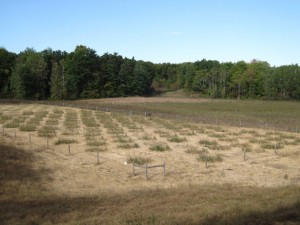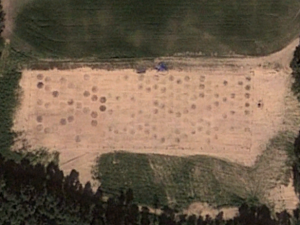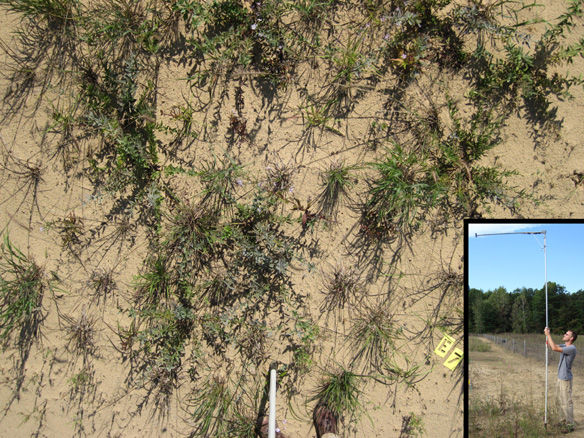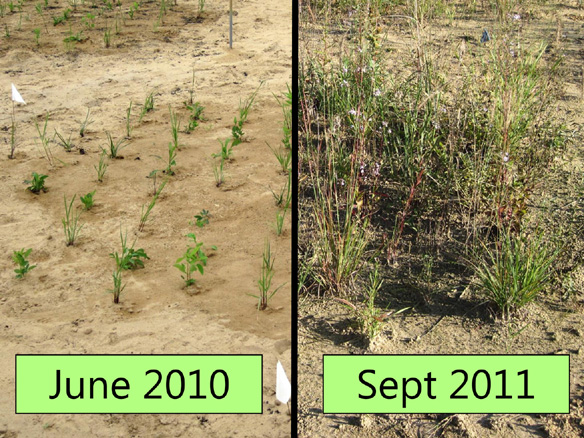Previous Page – General Research Interests
PhD Research
Partnership: Nature Conservancy of Canada and The Ontario Aggregate Resource Corporation
One of the aims of the  Management of Abandoned Aggregate Properties program (MAAP program) is to convert abandoned pits and quarries into functioning ecosystems with practical land management tools. Native plant restoration is a relatively young discipline. New strategies and innovative practices are constantly being developed. The grassland restoration techniques discussed in this article are currently being tested in a large-scale field trial as part of a restoration project in southern Ontario.
Management of Abandoned Aggregate Properties program (MAAP program) is to convert abandoned pits and quarries into functioning ecosystems with practical land management tools. Native plant restoration is a relatively young discipline. New strategies and innovative practices are constantly being developed. The grassland restoration techniques discussed in this article are currently being tested in a large-scale field trial as part of a restoration project in southern Ontario.
Grasslands are characterized by herbaceous vegetation such as wildflowers and grasses. Grasslands can be appreciated in many ways from their inherent aesthetic beauty, to the complexity of the interacting organisms, and the ecosystem services provided to humans such as greenhouse gas sequestration. Currently, southern Ontario’s grasslands occur only as patches, occupying less than 3% percent of their original range. The reduction of grassland habitat threatens many species unique to these areas.
Ultimately, the goal of restoring expended sand and gravel pits is to create viable habitat for native plants and animals. The post-extraction landscape is characterized by low soil organic matter, a diminished community of soil organisms, and reduced soil stability. Plants attempting to colonize the disturbed area are presented with harsh environmental conditions. To address these limiting factors, a large-scale field trial was established to test several land management scenarios in an abandoned sand pit. This field trial tests the effect of soil amendments (biochar, compost) and microbial plant symbionts (commercially-available arbuscular mycorrhizal fungi) on native grassland plant survival and growth.
-
Arbuscular Mycorrhizal Fungi as a Soil Amendment
Arbuscular mycorrhizal fungi (AMF) are microscopic soil fungi that form a symbiotic relationship with almost all plants. Many studies have described potential benefits to plant growth by increasing: 1) nutrient uptake, 2) pathogen protection, and 3) seedling establishment. Because of these potential benefits, the use of AMF inoculum may increase plant establishment and survival in disturbed soils.
-
Biochar as a Soil Amendment
Biochar is carbon-rich charcoal produced by heating organic materials (e.g. corn stalks or wood chips) to high temperatures in a low oxygen environment. Biochar is a rediscovered, ancient way of boosting soil fertility by adding a long-term, stable form of carbon to the soil. There is evidence that biochar will stimulate AMF communities, increase water and nutrient retention, and enhance plant growth. In addition, the structure of biochar resists breakdown for 100-1,000+ years, thus acting as a sink for atmospheric CO2 when added to soils.
-
Compost as a Soil Amendment
Compost is typically derived from leaf and yard waste, a by-product of community segregated waste collections. Compost derived from municipal processing facilities is utilized in gardens, agriculture, land reclamation, and slope stabilization projects. As an amendment, composted organic matter can benefit soils by increasing soil organic carbon, essential plant nutrients, and soil water holding capacity. In addition, compost contains a complex food web of beneficial soil organisms. These organisms may benefit the overall health of the soil and stimulate plant growth.
Grassland Restoration Project in Southern Ontario

Photo 2: Google Earth images of the restoration site established in summer 2010. (Site Size = 0.5 ha, Plot Size = 10.2 m^2
Our research team at the University of British Columbia – Okanagan and the University of Guelph has partnered with MAAP and The Nature Conservancy of Canada (NCC) at a site near St. Williams, Ontario. The St. Williams area is within the historic range of grassland ecosystems in southern Ontario, making this location an ideal candidate for grassland restoration. The experiment is established on a recently active sand pit (0.5 hectares). In May 2010, an earth mover graded the sand pit in order to minimize soil topographical variability in the project. The resulting conditions represented depleted pit conditions since topsoil was not replaced at the study site. With the land surface homogenized, we began the establishment of the experimental field plots in Spring 2010. Plant material was grown at the St. Williams Nursery and Ecology Centre in association with Pterophylla.
-
Experiment #1 – Plant Plug Experiment:
In the first experiment, we grew over 8,000 grassland plants under different conditions (+/- amendments; +/- AMF) to see if they enhance plant plug survival and growth in the field. The mycorrhizal inoculation of the plant plugs was performed in the greenhouse. Carbon amendments were applied at rates economically viable for large-scale pit restoration projects. The experiment was set up in Spring 2010 and has fully established with good rates of germination in all plots.
-
Experiment #2 – Plant Seed Experiment:
In the second experiment, we are testing the use of seeds in place of plant plugs in post-extraction grassland restorations. Native grassland plant seeds are adapted to frozen winters followed by moist spring conditions. This benefits the industry because the restoration season can be extended and seed use is more cost efficient. When restoring grasslands, many native plant species must be cold, moist stratified in order for germination to occur. Cold / moist stratification can be easily mimicked in the greenhouse. For our experiment, seeds were applied in early April 2011. Here, we applied seeds from common grassland species to 72 field plots under different conditions (+/- amendments; +/- AMF).
Analyses:
In order to track plant growth without affecting plant establishment, we developed innovative, non-destructive plant measurement techniques. Using an overhead photograph of each plot, we determined the percentage of green pixels to approximate the percent cover of the plants. We combined this with measuring physical aspects of each species. Together, these measurements will approximate plant biomass. In addition, soil cores were also collected from each plot to determine the presence and composition of AMF in plant roots.

Photo 3: Brian Ohsowski takes an overhead photograph to analyze plant cover. The overhead photograph shown here represents a high plant growth plot (Photo Taken: September 2011).
Conclusion:
This study tests simple and practical ways of improving the success of grassland restoration that could be easily applied to industrial-scale land restoration. The biotic and abiotic amendments in this project are designed with the intention of long-term cost savings to the aggregate extraction industry by maximizing native grassland plant establishment. Overall, the use of these land management tools may lead to faster recovery time of grassland habitats. Faster habitat recovery time and minimized plant failure will result in quicker and more successful rehabilitation.
